يا سماء الشرق / Sky Over The East at the Emirates Palace Gallery
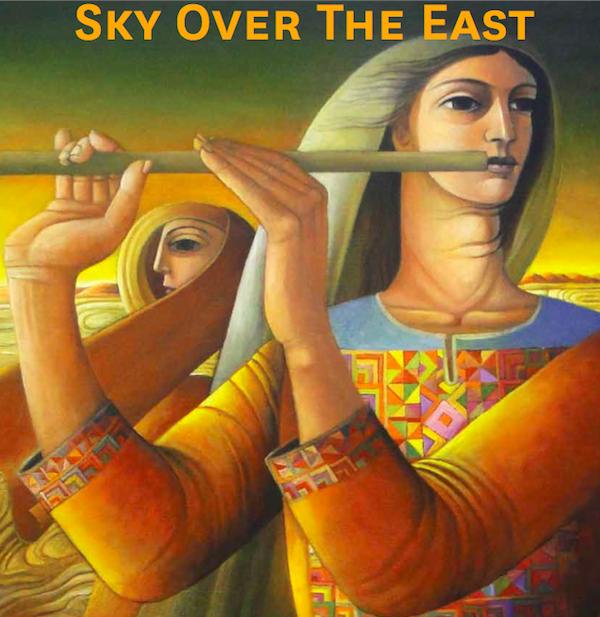
I recently visited the exhibition Sky Over The East in Emirates Palace, Abu Dhabi. The exhibition is a collaboration between Abu Dhabi Music & Arts Foundation and Barjeel Art Foundation featuring works from the collection of Barjeel Art Foundation.
I am not a fan of visiting art exhibitions in hotels, but this is a must see. It's a museum quality exhibition featuring a fantastic collection of work by 48 Arab artists from the past 80 years. It "seeks to contextualize key milestones from the region’s modern history while testifying to the artist’s role as a vital contributor to the intellectual development of society."
The selection of works displayed provides a glimpse into the diversity of subjects that preoccupied artists in the Arab world over the past 86 years, while also highlighting relationships that existed among cultural production in different countries, and across several decades.
I hope that the exhibition encourages a wider discourse on Arab art and sheds light on the work of leading masters from the region, many of whom are still practicing today. Geographically spanning over 12 countries and two continents, the selection of art presented calls attention to a shared identity of Arab nations, while contributing to a wider public appreciation of the visual arts.
Sultan Sooud Al Qassemi - Founder, Barjeel Art Foundation
The Arabic title يا سماء الشرق (Ya Sama'a Al Sharq) is far more poetic and comes from the song دعاء الشرق (Dua'a Al Sharq) / Prayer of the East by Mohammed Abdel Wahab, based on a poem by Mahmoud Hassan Ismail. Here's a detailed explanation on why this title was chosen and its relevance.
Composed in 1953, Prayer of the East (Du’aa Al Sharq) made its way into thousands of Arab households in the few years that followed. Put to music and delivered by the renowned Mohammed Abdel Wahab, the lyrics are based on Mahmoud Hassan Ismail’s poem that highlights collective aspects of the Arab spirit and alludes to a shared metaphoric sky under which Arab communities exist. Broadcast via the newly established Sawt Al Arab (a radio channel set up in Egypt in the early 1950s under President Gamal Abdel Nasser) the song quickly gained popularity with the Arab audience and became akin to a universal Arab hymn of the latter part of the 20th century.
Since the 1970s, linguistic derivatives of the words ‘East’ and ‘Orient’ in relation to descriptions of land populated by Arab nations have been questioned and critiqued as terms linked to 20th-century colonialism. The title of this exhibition by no means attempts to serve as a geographical indicator defining physical territories inhabited by Arab societies. Rather, it aims to reference an instance in modern Arab history, when a cultural product served to unify distinct communities and entire nations under a single umbrella of shared identity.
Modes within which Modern Arab artists worked extended from naturalistic documentation of people and landscapes, to creating socio-political commentaries, exploring theological matters, and addressing intimate, personal narratives and concerns. In line with the song’s call to preserve collective memories, 20th-century Arab artists reflected on and re-examined their histories within the context of global developments. They tackled notions of Arab identity, while being influenced by the evolution of European Modernism and work of masters like Henri Matisse, Willem de Kooning and Antoni Tàpies among others. With no single thematic or stylistic thread running through this exhibition, there exist multiple links and relationships between individual works of art, which despite being separated by geography and time, often address similar questions, take on similar approaches and display a shared ethos.
Suheyla Takesh - Curator, Barjeel Art Foundation
The exhibition is on till 27th June 2014. I cannot stress enough how important this exhibition is. There is work that will make you smile, make you sad, make you think.
If you live in the UAE and interested in art, especially from the Middle East, then make sure you don't miss this. Below is a small selection of work from the exhbition and some of my favourites. I suggest you listen to the song دعاء الشرق (Dua'a Al Sharq) / Prayer of the East by Mohammed Abdel Wahab whilst looking at the images and reading about the artists.
li Al Abdan
United Arab Emirates. b. 1972
Ali Al Abdan - On Al Khan Beach. 1989. Oil on canvas. 59 X 69 cm.
Ali Al Abdan is an Emirati artist, interested in documenting history and preserving traditions in visual, as well as written form. He often creates elaborate collages that tell stories of specific people, while shedding light on a larger picture of the times. He had a solo show entitled I am Ali Al Abdan at Emirates Fine Art Society, Sharjah in 2010. He has also written a book on the history of art in the UAE.
Baya
Algeria. 1931–1998
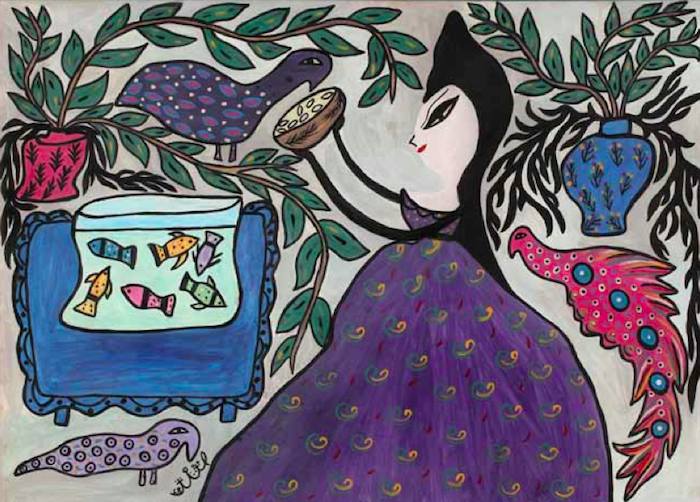
Baya - Femme aux Deux Paons Avec Aquarium (Woman with Two Peacocks and Aquarium). 1968. Watercolour and gouache on paper. 66 X 92 cm.
Baya was born at Bordj El Kiffan in Algeria in 1931, and by age five had lost both her parents. She was looked after by her grandmother, and subsequently adopted by a French woman Marguerite Benhour, who took her to Paris. In 1947 Benhoura arranged for the talented 16 year old Baya to have her first solo exhibition at the Galerie Adrien Maeght in Paris. Her work was widely praised and admired for its childlike quality and naiveté by the likes of Pablo Picasso who, following their meeting in Paris, became Baya’s good friend.
Hamed Nada
Egypt. 1924–1990
Hamed Nada - Dancing by the Beach. 1984. Acrylic and crayon on board. 44 X 33.5 cm.
Born in Alexandria, Hamed Nada was inspired by the dichotomy between hardships of impoverished people he witnessed on a day-to-day basis in his home country, and the traditional folk tales that held in them worlds of fantasy and encouraged daring flights of imagination. A lot of his work draws references from Western artistic styles, and is likened to the work of European masters such as Henri Matisse.
Hassan Sharif
United Arab Emirates. b. 1951
Hassan Sharif - Man. 1980. Oil on paper. 92.7 X 73.5 cm.
Hassan Sharif is widely recognised as the grandfather and pioneer of conceptual and experimental art in the UAE. Rather than working within a single discipline, his practice unites various media and approaches, such as performance, installation, photography, painting and drawing, among others. Much of Hassan Sharif’s work explores notions of consumerism and obsession with commercial goods. The greyscale composition on paper reflects his experience of working on caricatures for local newspapers and magazines in the 1970s.
Khudair Shakirji
Iraq. 1937-2006
Khudair Shakirji - Untitled. 1981. Oil on canvas. 98 X 98 cm.
Khudair Shakirji graduated from the Fine Arts Academy in Baghdad, and subsequently joined the Baghdad Modern Art Group, being influenced by artists like Shakir Hassan Al Said and Jabra Ibrahim Jabra. Shakirji’s work often draws references to Arab traditions and folklore, while being distinguished by modern compositions and approaches. He had five solo exhibitions at the Iraqi Artists Society, and his work is in the collection of Iraq’s National Museum of Modern Art.
Laila Shawa
Palestine. b. 1940
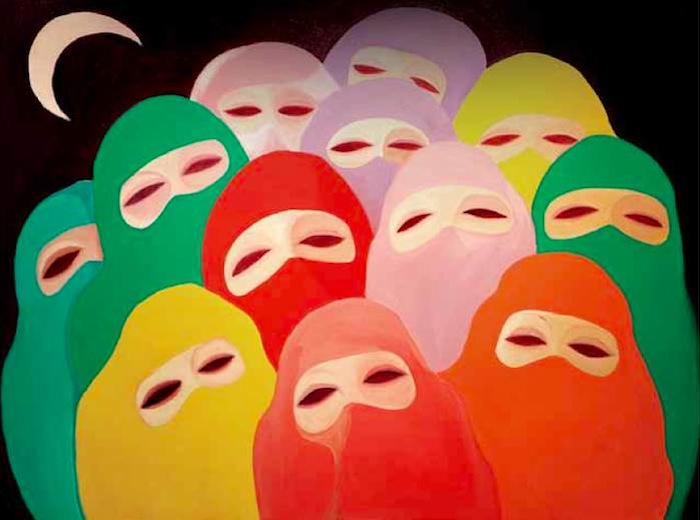
Laila Shawa - Moon Walkers. 1988. Acrylic on canvas. 75 X 100 cm.
Palestinian artist Laila Shawa is known for her use of bold colours and illustrative designs to tackle issues of violence, political turmoil, the plight of children and resistance in her native country. Shawa paints, photographs and uses silk screen prints in her work. The artist studied in Cairo, Rome, and Austria, and worked for United Nations children’s art programs in Gaza in the 1960s. Her work has been exhibited around Europe, the Arab world, Russia, China, Malaysia and the United States.
Layla Al Attar
Iraq. 1940-1993
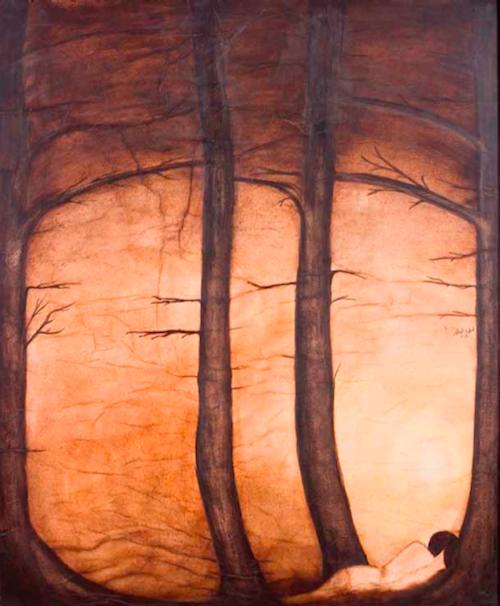
Layla Al Attar - Untitled. 1988. Oil and encaustic on paper on canvas. 98.5 X 82 cm.
The late Iraqi artist Layla Al Attar was revered during her life as a gifted painter who hosted five solo exhibitions in her homeland and served as director of the Iraqi National Art Museum. The primordial forest, as well as representations of Adam and Eve are recurrent themes in Al Attar’s work. She often uses distortions of space and light to point to the sense of unreality of this world. Al Attar lost her life in an explosion that also killed her husband during the bombing of Iraq in 1993.
Louay Kayyali
Syria.1934-1978
LouayKayyali - Woman Sewing. 1974. Oil on masonite. 94.5 X 94.5 cm.
Depictions of banal daily struggles and the social and physical deprivation of the masses intertwine the artwork of Syrian painter Louay Kayyali during his iconic, short-lived career. The Aleppo-born artist began painting at the age of 11 and held his first solo show at 18. Highlighting the individual struggles evident on the fringe of larger socio-political realities in the Arab region, Kayyali’s artwork provides a window into the lives of the deprived majority. Woman Sewing captures a fleeting moment of a seamstress’ ascetic routine of stitching clothing.
Mahmoud Said
Egypt. 1897–1964
Mahmoud Said - Le Canal de Mahmoudieh. 1922. Oil on panel. 27.5 X 45 cm.
Mahmoud Said was a lawyer who worked at the Mixed Courts in Alexandria until the late 1940s, only painting in his spare time. He subsequently decided to quit his desk job, in order to dedicate himself fully to art and explore his passion for painting. Like many of his contem- poraries, Said was fascinated with depicting Egyptian landscapes and picturesque coastal areas around the Nile. He often painted on very small canvases, later reworking his sketches onto a larger scale in his studio.
Mohammed Issiakhem
Algeria. 1928–1985
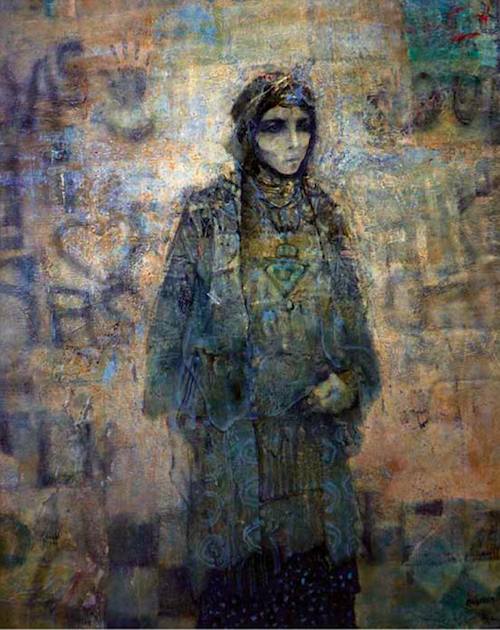
Mohammed Issiakhem - emme et Mur (Woman and Wall). Date unknown. Oil on canvas. 162 X 130 cm.
Mohammed Issiakhem spent most of his childhood in Relizane, Algeria. He started his artistic training at the École des Beaux-Arts, Algiers in 1948, where he studied fine art and miniature painting. He co-founded the Union Nationale des Arts Plastiques in 1963, and from 1964 to 1966, he was the director of the École des Beaux-Arts in Oran. In 1971, he was professor of graphic art at the École Polytechnique d’Architecture et d’Urbanisme, Algeria. Much of Issiakhem’s work centres around the depiction of women and drawing references to Algerian traditions.
Mohammed Naghi
Egypt. 1888–1956
Mohammed Naghi - Le Café à Chypre. 1950. Oil on canvas on masonite. 45 X 59.5 cm.
Before beginning his art education in Florence in 1910, Mohammed Naghi studied law at the University of Lyons in 1906-10. In 1919 he spent some time in France, developing his painting skills with Claude Monet and working on depictions of the French countryside. Mohammed Naghi returned to Egypt shortly, becoming involved with the 1919 revolution. This experience helped him get closer to the population and enriched his appreciation of Egyptian heritage.
Mohammed Sabry
Egypt. b. 1917
Mohammed Sabry - Village. Date unknown. Pastel on paper. 43 X 60 cm.
Sabry graduated from the Faculty of Arts in Cairo and continued his studies in Madrid at the Royal Academy of Fine Arts of San Fernando. In 1952 he attained a professorship there, and in 1988, he was awarded the Queen Isabella medal by the King of Spain. Born in 1917, Sabry has witnessed almost a century of political and social history, and this certainly reflected in his work as an artist. A lot of his work was executed in the impressionist style, and depicted Cairo, Aswan, as well as Spanish scenery.
Seif Wanly
Egypt. 1906–1979
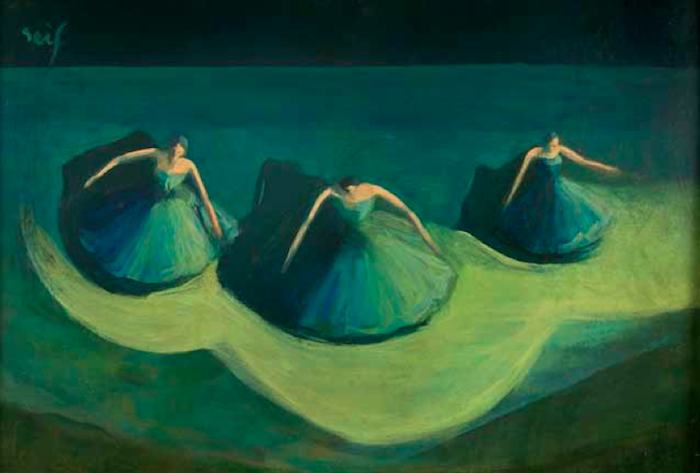
Seif Wanly - Ballerinas. c. 1960. Oil on panel. 78.6 X 108.2 cm.
Born in Alexandria into an aristocratic Egyptian family, Wanly was privately tutored in art. In his portraits we often find characters in self-reflective gestures, detached from their context. While some of his paintings capture live entertainment, theatre and musical performances, Wanly’s primary concentration was to depict daily life.The artist established an art studio in Cairo in the 1940s with his brother Adham Wanly that was open to the public and any-one interested in the arts.
Suleiman Mansour
Palestine. b. 1947
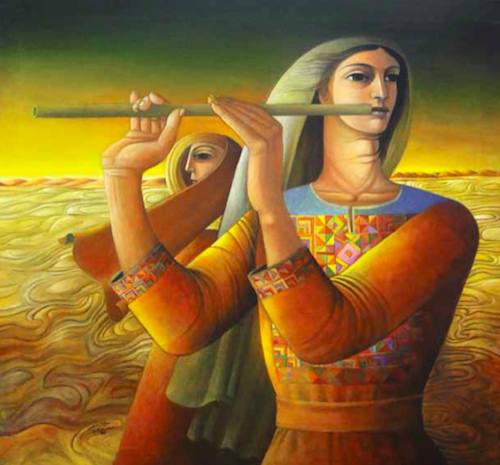
Suleiman Mansour - Sad Tunes. 1977. Oil on canvas. 87 X 90 cm.
Among the most recognised and distinguished Palestinian artists is Suleiman Mansour, who has tailored his comprehensive portfolio around the Palestinian struggle, portraying peasants and women in traditional dress in his early work. For Mansour, art aids the continua- tion and revival of Palestinian identity, particularly as it captures images of the land and people working on it. By keeping his artistic roots in the ancestral homeland, the artist enables Palestinians to continue to lay claim to it.
Event details
Date: On till Friday, 27th June 2014 between 12:00 pm-8:00 pm
Venue: Emirates Palace Gallery, Emirates Palace, Abu Dhabi (location map)
Free entry.
www.barjeelartfoundation.org/exhibitions/sky-over-the-east
www.admaf.org/en/event/sky-over-the-east-works-from-the-collection-of-barjeel-art-foundation







